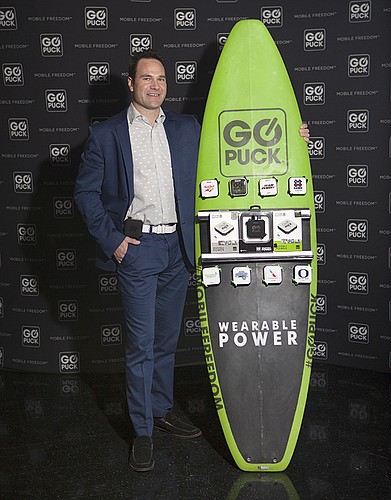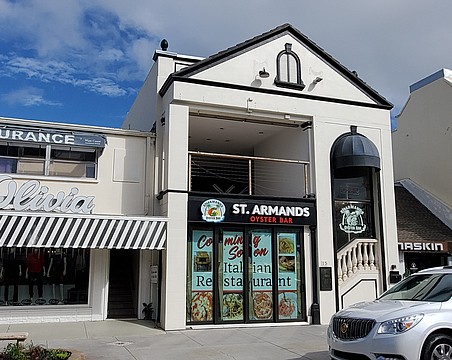Executive Summary
Company. Go Puck Industry. Technology, retail Key. Company aims to quickly raise sales and brand awareness.
Entrepreneur Blake Fuller is no doctor, but he talks often about connection anxiety.
That's the overpowering feeling your battery-powered device will run out of juice at the most inopportune time. “We live in the age of muscle cars for technology devices,” Fuller says. “But we are on the edge of a battery crisis.”
Fuller believes he's got the cure to connection anxiety: Go Puck, his version of what he calls wearable power. From Fuller's Manatee County-based company under the same name, Go Puck stands for Portable USB Charging Kit. Fuller launched the company in 2012.
The size of two stacked square hamburger patties, a Go Puck can fit easily into a pocket, a purse, or the palm of a user's hand. It can rapidly charges two gadgets at a time, and works with all USB-powered devices, from phones to cameras. Modeled partly after GoPro, the popular extreme action cameras, a Go Puck can also be strapped or mounted to a device.
“If we don't have the (battery) power to give ourselves true mobility then we don't have true freedom,” Fuller says. “This is something that everyone wants, and everyone needs.”
The core challenge Fuller, 36, and the 20 employees at Go Puck face is to get the on-the-go charger in people's hands quickly, while also building a long-term sustainable brand. It's a pressing challenge because the mobile battery power industry is highly competitive. Global sales increased 50% from 2010 to 2015, according to Boulder, Colo.-based Pike Research, from $20.3 billion to $30.5 billion. Portable power represents at least 55% of the global battery industry.
Industry leaders include Mophie, which makes a mobile battery phone case certified by Apple and several other portable power devices. Mophie sells products in at least 100 countries and has more than $200 million in sales a year. The company has also invested big in its brand: It ran a popular Super Bowl ad last year, where the world goes into chaos because a God-like character has a dead phone battery. Many other big companies make portable battery power devices, including Samsung, Best Buy's in-house brand Insignia and Juno Power.
“It's a very crowded market,” says Go Puck co-founder and Chief Development Officer Lance Jones, a former marketing executive with multiple companies including Xerox, the Disney Channel and Budweiser King Racing. “There are a million quote-unquote 'portable chargers' in the market.”
Smart phones
That's why Go Puck, say Fuller and Jones, needs to stand out, both in quality and brand awareness, for the company to grab a chunk of market share. There are 13 device patent claims on Go Puck and a dozen more patent claims for the mount. One of the designers behind the Go Puck technology, says Fuller, is Anil Paryani, a patent holder on the battery algorithms for the Model S Tesla.
The design and prototype work for Go Puck is done in the firm's Manatee County facility, while initial assembly takes place in China. Final assembly, testing and shipping is done out of Manatee County. Fuller says he's in the process of finding a new factory in China, where he can have more control of assembly. That kind of control is key, says Fuller, because the company hopes to dramatically expand production, from 50,000 units a year to at least 500,000.
There are two lines of Go Pucks, 3X and 5X. The names come from the amount of times a Go Puck can charge a standard size smartphone before the Go Puck itself needs more juice.
A new line, 6XR, is under production and could be released later this year. The 6XR, say Go Puck officials, uses Qualcomm Quick Charge 2.0 technology, for a charge that's even faster than conventional USB charging.
Fuller says he's invested millions over the last three years to develop, test and get the Go Puck ready for market. Those funds came mostly from friends and family, and Fuller's own savings. Fuller also recently launched a capital raise for up to $20 million, money for marketing, branding and research and development.
Navigating challenges
Go Puck made its commercial debut in 2013, at the millennial and technology-infused South by Southwest festival in Austin. The response in Texas was overwhelming, Fuller says, and a tipping point on his “awareness of the market.”
Go Pucks are now sold on Amazon and in at least 500 retail outlets, including more than 230 Dunham's Sports locations in the Southeast and Midwest. In the Sarasota area, Go Pucks are sold at Fleet Feet, Molly's Boutique and Environeers.
The Go Puck 3X retails for $60, the 5X is $80 and an active mount for strapping it costs $20, pricing that puts Go Puck in the mid-market range. Fuller declines to release annual sales figures, only to say the firm could surpass $30 million in 2016, depending on when 6XR launches.
Even while navigating manufacturing and inventory challenges, Fuller says the prospects for Go Puck are boundless, given there are an estimated 9 billion devices worldwide that need a recharge. Just 1% of that market, says Fuller, would be a good start. “We aren't going for a niche market,” he says. “We want the bigger opportunity.”
Fuller has led a battery power business once before. That firm, Manatee County-based Braille Battery, developed and sold lightweight, lithium-ion car-starting batteries. Clients included teams and manufacturers in the IndyCar, Nascar and Formula 1 racing circuits, in addition to high-end car owners, and the company had more than 500 resellers of its batteries worldwide. Fuller sold Braille Battery in 2014 to focus on Go Puck.
'Not easy'
The sales and branding strategy at Go Puck is concentrated in three areas.
One focus is hospitality, particularly resorts, sports arenas and amusement parks. The idea there, says Jones, is to target places where people share a lot of memories on their devices, the type of usage that eats up a phone's battery. The company aims to have deals with multiple hotels for Go Pucks, so the property can provide the devices for guests, in rooms or at the lobby/bar. One big deal the company recently reached is with Universal Studios Orlando, which recently began to rent Go Pucks to guests for $25 a day or $12.50 for a half-day.
Another focus to help build the brand is to get Go Puck in front of celebrities. A Go Puck, for example, was inserted in swag bags given to actors and actresses staying at the Four Seasons Hotel for the Golden Globes awards in January. Fuller says the company also hopes to give away a Go Puck to every player at the NBA All-Star game in February in Toronto.
A final market segment is retail, which Fuller has learned comes with multiple hurdles. Challenges include finding the just-right packaging, shelf-placement and not getting lumped in with competitors and finding the perfect price point. The retail side of the business has been Fuller's biggest pain point lately. “You can't underestimate the amount of time it takes to prepare for retail,” says Fuller. “It's not easy.”
South of the Border
Go Puck executives Blake Fuller and Lance Jones have spoken with dozens of potential investors and partners for their company, which makes a portable charging device for mobile gadgets.
The list includes founders and top executives with a wide range of companies, from GoPro and Google to PayPal and the Disney Channel. Jones uses contacts built during a 35-year career in corporate America, while Fuller has deep connections in auto racing.
One pitch the duo made that stands out is when they got in front of Mexican businessman and multibillionaire Carlos Slim. Fuller and Jones, through acquaintances and connections, were invited to Slim's Mexico City house last year. While Slim didn't invest in Go Puck, he's considering a deal to stock hotels he owns with the devices, says Jones.
And the Go Puck executives scored another kind of victory with Slim: proof of concept. “He brought some Go Pucks home,” says Jones, who has kept in touch with Slim through texts since the visit. “His wife and kids took them, and they loved them so much they didn't give them back.”
— Mark Gordon






